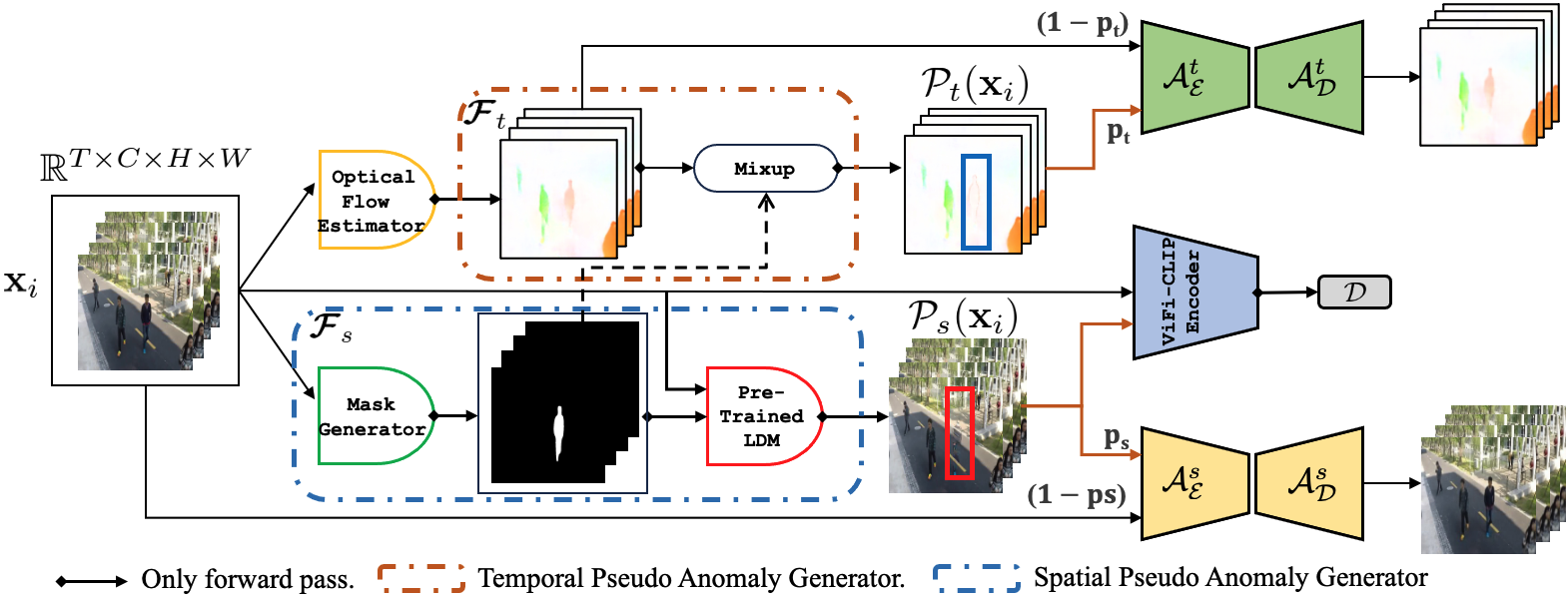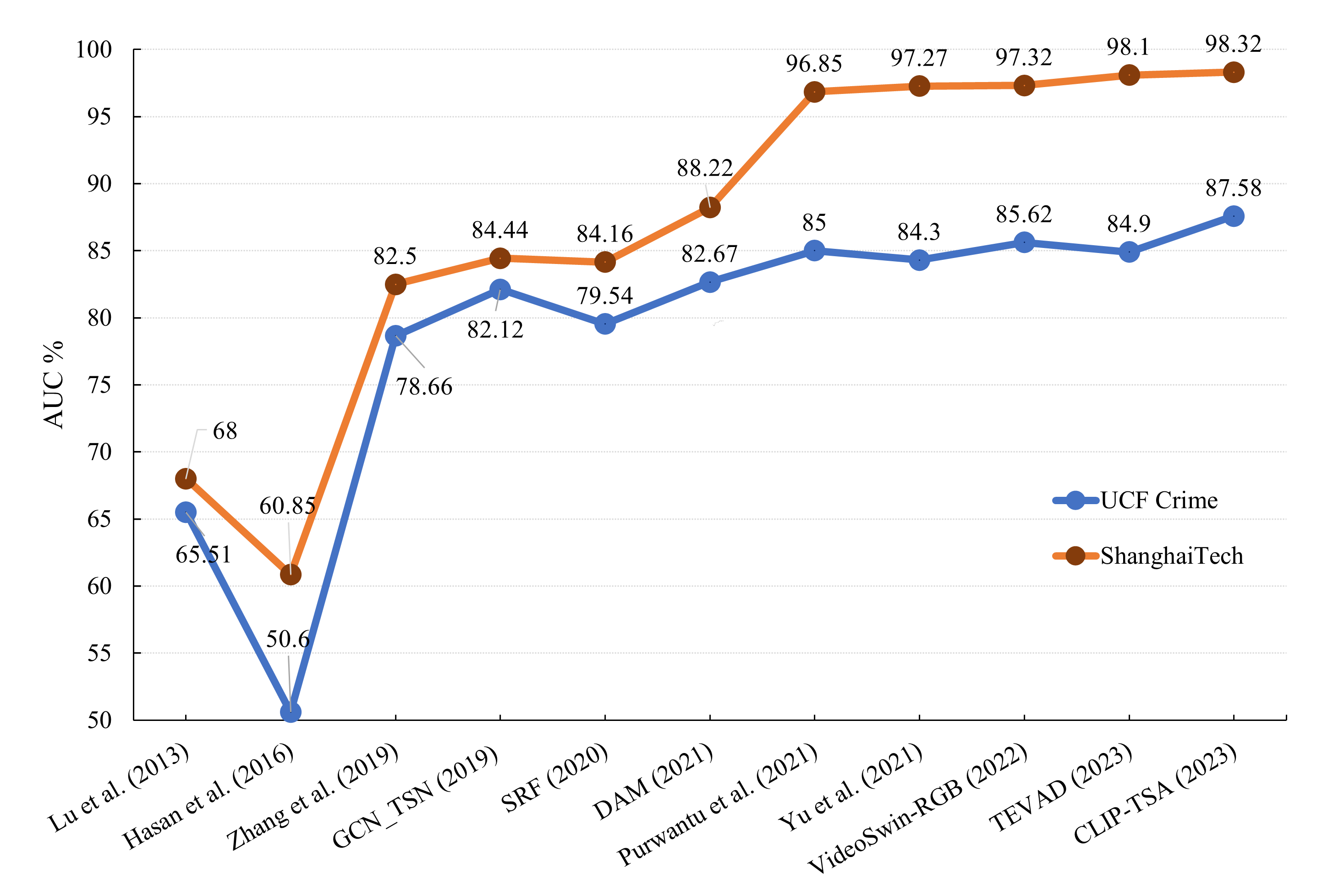Bounding Boxes and Probabilistic Graphical Models: Video Anomaly Detection Simplified

0

Sign in to get full access
Overview
- This paper proposes a new approach for video anomaly detection using bounding boxes and probabilistic graphical models.
- The key idea is to leverage bounding boxes to capture the spatial and temporal relationships between objects in a video, and then use probabilistic graphical models to model the normal behavior and detect anomalies.
- The authors claim that this approach simplifies the video anomaly detection problem and achieves strong performance on benchmark datasets.
Plain English Explanation
The paper focuses on the problem of video anomaly detection, which is about automatically identifying unusual or abnormal events in video footage. This is a challenging task because normal behavior can vary greatly across different environments and scenarios.
The researchers' approach is to use bounding boxes to capture the locations and movements of objects in the video. Bounding boxes are rectangular regions that enclose an object of interest, like a person or a vehicle. By tracking the bounding boxes over time, the system can learn the typical patterns of how objects move and interact within the scene.
The researchers then use probabilistic graphical models to represent these spatial and temporal relationships between the bounding boxes. Probabilistic graphical models are a powerful tool for modeling complex dependencies and uncertainties in data. In this case, the model can learn what constitutes "normal" behavior and flag any deviations as potential anomalies.
This approach has several advantages over previous methods for video anomaly detection. First, it simplifies the problem by focusing on the bounding boxes rather than attempting to model the entire video scene. Second, the probabilistic graphical model provides a principled way to reason about uncertainty and detect anomalies. And third, the technique can be applied to a wide range of video surveillance and monitoring applications, from autonomous vehicles to smart cities.
Technical Explanation
The key innovation in this paper is the use of bounding boxes and probabilistic graphical models to tackle the video anomaly detection problem. The researchers start by detecting and tracking bounding boxes around objects of interest in the video. This provides a concise representation of the spatial and temporal relationships between the objects, without having to model the entire video scene in detail.
Next, the researchers construct a probabilistic graphical model to capture the typical patterns of object motion and interaction. Specifically, they use a Markov random field to model the joint distribution of the bounding box locations and velocities over time. This allows the model to learn the normal behavior of the scene and identify any deviations as potential anomalies.
The researchers evaluate their approach on several benchmark datasets for video anomaly detection, including UCSD Ped1, CUHK Avenue, and ShanghaiTech. They show that their method outperforms several state-of-the-art techniques in terms of both detection accuracy and computational efficiency.
Critical Analysis
The researchers make a strong case for the effectiveness of their bounding box and probabilistic graphical model approach for video anomaly detection. The use of bounding boxes provides a compact and interpretable representation of the scene, while the probabilistic graphical model allows for principled reasoning about normal and abnormal behavior.
However, the paper does not address some potential limitations of the approach. For example, the reliance on accurate object detection and tracking could be a source of error, especially in crowded or cluttered scenes. Additionally, the Markov random field model may not be able to capture more complex spatio-temporal dependencies in the data.
It would also be valuable to see the researchers explore the explainability of their model, as this is an important consideration for real-world applications of video anomaly detection. Being able to understand why the model flags a particular event as anomalous can help build trust and facilitate the deployment of these systems in sensitive domains like surveillance and public safety.
Conclusion
This paper presents a novel approach to video anomaly detection that leverages bounding boxes and probabilistic graphical models. By focusing on the spatial and temporal relationships between objects, the researchers have developed a simplified yet effective technique that outperforms state-of-the-art methods on several benchmark datasets.
The key contribution of this work is the synergistic combination of bounding boxes and probabilistic modeling, which allows for robust and efficient anomaly detection in complex video scenarios. This could have important implications for a wide range of applications, from autonomous vehicle safety to smart city surveillance.
Future research could address some of the potential limitations of the approach, such as the reliance on accurate object tracking and the need for greater model explainability. Nevertheless, this paper represents a significant step forward in the field of video anomaly detection and demonstrates the power of integrating computer vision and probabilistic reasoning techniques.
This summary was produced with help from an AI and may contain inaccuracies - check out the links to read the original source documents!
Related Papers


0
Bounding Boxes and Probabilistic Graphical Models: Video Anomaly Detection Simplified
Mia Siemon, Thomas B. Moeslund, Barry Norton, Kamal Nasrollahi
In this study, we formulate the task of Video Anomaly Detection as a probabilistic analysis of object bounding boxes. We hypothesize that the representation of objects via their bounding boxes only, can be sufficient to successfully identify anomalous events in a scene. The implied value of this approach is increased object anonymization, faster model training and fewer computational resources. This can particularly benefit applications within video surveillance running on edge devices such as cameras. We design our model based on human reasoning which lends itself to explaining model output in human-understandable terms. Meanwhile, the slowest model trains within less than 7 seconds on a 11th Generation Intel Core i9 Processor. While our approach constitutes a drastic reduction of problem feature space in comparison with prior art, we show that this does not result in a reduction in performance: the results we report are highly competitive on the benchmark datasets CUHK Avenue and ShanghaiTech, and significantly exceed on the latest State-of-the-Art results on StreetScene, which has so far proven to be the most challenging VAD dataset.
Read more7/9/2024


0
A Lightweight Video Anomaly Detection Model with Weak Supervision and Adaptive Instance Selection
Yang Wang, Jiaogen Zhou, Jihong Guan
Video anomaly detection is to determine whether there are any abnormal events, behaviors or objects in a given video, which enables effective and intelligent public safety management. As video anomaly labeling is both time-consuming and expensive, most existing works employ unsupervised or weakly supervised learning methods. This paper focuses on weakly supervised video anomaly detection, in which the training videos are labeled whether or not they contain any anomalies, but there is no information about which frames the anomalies are located. However, the uncertainty of weakly labeled data and the large model size prevent existing methods from wide deployment in real scenarios, especially the resource-limit situations such as edge-computing. In this paper, we develop a lightweight video anomaly detection model. On the one hand, we propose an adaptive instance selection strategy, which is based on the model's current status to select confident instances, thereby mitigating the uncertainty of weakly labeled data and subsequently promoting the model's performance. On the other hand, we design a lightweight multi-level temporal correlation attention module and an hourglass-shaped fully connected layer to construct the model, which can reduce the model parameters to only 0.56% of the existing methods (e.g. RTFM). Our extensive experiments on two public datasets UCF-Crime and ShanghaiTech show that our model can achieve comparable or even superior AUC score compared to the state-of-the-art methods, with a significantly reduced number of model parameters.
Read more7/8/2024


0
Video Anomaly Detection via Spatio-Temporal Pseudo-Anomaly Generation : A Unified Approach
Ayush K. Rai, Tarun Krishna, Feiyan Hu, Alexandru Drimbarean, Kevin McGuinness, Alan F. Smeaton, Noel E. O'Connor
Video Anomaly Detection (VAD) is an open-set recognition task, which is usually formulated as a one-class classification (OCC) problem, where training data is comprised of videos with normal instances while test data contains both normal and anomalous instances. Recent works have investigated the creation of pseudo-anomalies (PAs) using only the normal data and making strong assumptions about real-world anomalies with regards to abnormality of objects and speed of motion to inject prior information about anomalies in an autoencoder (AE) based reconstruction model during training. This work proposes a novel method for generating generic spatio-temporal PAs by inpainting a masked out region of an image using a pre-trained Latent Diffusion Model and further perturbing the optical flow using mixup to emulate spatio-temporal distortions in the data. In addition, we present a simple unified framework to detect real-world anomalies under the OCC setting by learning three types of anomaly indicators, namely reconstruction quality, temporal irregularity and semantic inconsistency. Extensive experiments on four VAD benchmark datasets namely Ped2, Avenue, ShanghaiTech and UBnormal demonstrate that our method performs on par with other existing state-of-the-art PAs generation and reconstruction based methods under the OCC setting. Our analysis also examines the transferability and generalisation of PAs across these datasets, offering valuable insights by identifying real-world anomalies through PAs.
Read more4/9/2024


0
Video Anomaly Detection in 10 Years: A Survey and Outlook
Moshira Abdalla, Sajid Javed, Muaz Al Radi, Anwaar Ulhaq, Naoufel Werghi
Video anomaly detection (VAD) holds immense importance across diverse domains such as surveillance, healthcare, and environmental monitoring. While numerous surveys focus on conventional VAD methods, they often lack depth in exploring specific approaches and emerging trends. This survey explores deep learning-based VAD, expanding beyond traditional supervised training paradigms to encompass emerging weakly supervised, self-supervised, and unsupervised approaches. A prominent feature of this review is the investigation of core challenges within the VAD paradigms including large-scale datasets, features extraction, learning methods, loss functions, regularization, and anomaly score prediction. Moreover, this review also investigates the vision language models (VLMs) as potent feature extractors for VAD. VLMs integrate visual data with textual descriptions or spoken language from videos, enabling a nuanced understanding of scenes crucial for anomaly detection. By addressing these challenges and proposing future research directions, this review aims to foster the development of robust and efficient VAD systems leveraging the capabilities of VLMs for enhanced anomaly detection in complex real-world scenarios. This comprehensive analysis seeks to bridge existing knowledge gaps, provide researchers with valuable insights, and contribute to shaping the future of VAD research.
Read more7/2/2024